Indicator-Based Sustainability Assessment Tool to Support Coastal and Marine Management
Abstract
:1. Introduction
2. Methodology and Study Sites
2.1. Setting Indicators and Indicator-Based Sustainability Assessment Tool (InSAT)
2.2. Application Process
2.3. Description of the Study Sites
2.3.1. The Liquefied Natural Gas (LNG) Terminal at Klaipeda Harbor
2.3.2. Port of Sventoji
2.3.3. Beach Opening in Nida
3. Results and Discussion
3.1. InSAT Assessment Process: Indicators as Early Warning Signals
3.1.1. Implemented Measures: The LNG Terminal in Klaipeda
3.1.2. Measure Implementation in Progress: The Port of Sventoji
3.1.3. Hypothetical Scenarios: The New Beach Opening in Nida
3.2. Indicators along the SAF Process: Are We Moving toward Success?
3.3. InSAT as Decision Support Tool for Integrated Approaches
4. Conclusions
Author Contributions
Funding
Acknowledgments
Conflicts of Interest
Appendix A
| Core Indicators (MO—Management Option) | Categories |
| 1. The Management Option (MO) prevents air pollution and greenhouse gas emissions. | Pollution |
| 2. The MO prevents water pollution. | Pollution |
| 3. The MO prevents land and soil pollution. | Pollution |
| 4. The MO improves the status of water (ecological and chemical) quality. | Pollution |
| 5. The MO improves quality of water for human consumption. | Water resource management |
| 6. The MO reduces waste and supports and stimulates material reuse and recycling. | Waste management and Recycling |
| 7. The MO promotes flood prevention, protection, and mitigation. | Changes at the Coast and Adaptation |
| 8. The MO increases coastal erosion. | Changes at the Coast and Adaptation |
| 9. The MO increases the resilience and reduces vulnerability to climate change impacts. | Energy and Climate Mitigation |
| 10. The MO improves the sustainable management of coastal erosion. | Planning and management |
| 11. The MO effects land use planning and management. | Planning and management |
| 12. The MO supports urban planning and affects urban development. | Planning and management |
| 13. The MO increases the use of low-impact transport and supports sustainable mobility to the destination (including public transport). | Sustainable mobility |
| 14. The MO supports natural habitats, biodiversity, and the quality of those habitats. | Biodiversity and Nature Protection |
| 15. The MO supports policies and systems to conserve key natural sites (including marine and nature scenic, cultural, and wild landscapes). | Biodiversity and Nature Protection |
| 16. The MO contributes to increasing environmental awareness of the population. | Biodiversity and Nature Protection |
| Optional Indicators | Categories |
| 1. The MO supports environmentally friendly rural activities. | Biodiversity and Nature Protection |
| 2. The MO increases use of renewable energies. | Energy and Climate Mitigation |
| 3. The MO increases the local production of renewable energy. | Energy and Climate Mitigation |
| 4. The MO increases the pressure for coastal and marine recreation (the number of berths and moorings for recreational boating). | Tourism and Recreation |
| 5. The MO increases land take by intensive agriculture. | Biodiversity and Nature Protection |
| 6. The MO promotes environmentally friendly processes and products. | Biodiversity and Nature Protection |
| 7. The MO affects fish passage. | Biodiversity and Nature Protection |
| 8. The MO extends the length of artificially defended coastline (the coastline that has hard coastal defences). | Changes at the Coast and Adaptation |
| 9. The MO increases green buildings in the area. | Changes at the Coast and Adaptation |
| 10. The MO increases forested land area. | Biodiversity and Nature Protection |
| 11. The MO increases the amount of beach and marine litter. | Tourism and Recreation |
| 12. The MO improves bathing water quality. | Tourism and Recreation |
| 13. The MO contributes to wastewater treatment. | Waste management and Recycling |
| 14. The MO affects oil spill on the ecosystem. | Pollution |
| 15. The MO improves the quality of coastal rivers. | Pollution |
| 16. The MO increases opportunities to observe coastal & marine fauna. | Biodiversity and Nature Protection |
| 17. The MO increases the number of beaches and marinas awarded with a Blue Flag. | Tourism and Recreation |
| 18. The MO improves the status of marine fish stocks. | Biodiversity and Nature Protection |
| 19. The MO supports wildlife protection. | Biodiversity and Nature Protection |
| 20. The MO increases energy efficiency. | Energy and Climate Mitigation |
| Core Indicators (MO—Management Option) | Categories |
| 1. The MO affects financial policies and instruments to support economic stability and resilience. | Accounting and Regulation |
| 2. The MO ensures acceptable employment and training opportunities for local residents. | Labour and Welfare |
| 3. The MO increases economic diversification (the diversification of income sources away from domestic economic activities (i.e., income from overseas investment)). | Accounting and Regulation |
| 4. The MO increases payments and investments in coastal management. | Accounting and Regulation |
| 5. The MO promotes infrastructure development and increases environmental friendly transport. | Technology and Infrastructure |
| 6. The MO increases investment in innovation for a green economy (an economy that aims at reducing environmental risks and ecological scarcities and that aims for sustainable development without degrading the environment). | Production and Resourcing |
| 7. The MO increases investments on climate change adaptation and flood risk management. | Accounting and Regulation |
| 8. The MO supports local entrepreneurs and fair trade. | Production and Resourcing |
| 9. The MO affects direct investment (government, private sector, foreign direct investment, etc.). | Accounting and Regulation |
| 10. The MO affects tourism management and its strategy. | Tourism |
| 11. The MO increases culturally and environmentally friendly, low-impact tourism. | Technology and Infrastructure |
| 12. The MO increases total economic value (the value derived from a natural resource, a man-made heritage resource, or an infrastructure system). | Technology and Infrastructure |
| Optional Indicators | Categories |
| 1. The MO increases the volume of port traffic (e.g., incoming and outgoing passengers and the volume of goods handled per port). | Exchange and Transfer |
| 2. The MO financially affects the setting up and managing of an Marine protected areas (MPA) | Accounting and Regulation |
| 3. The MO ensures beaches with eco-labels. | Tourism |
| 4. The MO increases recreational boating. | Tourism |
| 5. The MO increases bed occupancy rate. | Tourism |
| 6. The MO increases vehicle ownership. | Consumption and Use |
| 7. The MO supports accessibility in island territories. | Technology and Infrastructure |
| 8. The MO affects aquaculture and fisheries production. | Production and Resourcing |
| 9. The MO supports the construction and modernization of fishing boats (including scraping). | Production and Resourcing (Consumption and Use) |
| 10. The MO increases tourism seasonal pressure (intensity of tourism). | Tourism |
| 11. The MO affects patterns of sectoral employment (full time, part time, and seasonal employment). | Labour and Welfare |
| 12. The MO increases productivity and the use of sustainable agriculture and fisheries. | Production and Resourcing |
| Core Indicators (MO—Management Option) | Categories |
| 1. The MO promotes social justice and equal opportunities for all members of society. | Freedom and Justice |
| 2. The MO improves quality of life (all people have a home and access to basic infrastructure and services). | Public Health and Wellbeing |
| 3. The MO provides educational opportunities, supports life-long learning, and increases awareness about sustainability. | Learning |
| 4. The MO protects, monitors, and safeguards local resident access to natural, historical, archaeological, religious, spiritual, and cultural sites. | Local Identity and Tradition |
| 5. The MO supports the conservation of cultural heritage (includes rural heritage). | Local Identity and Tradition |
| 6. The MO increases the production of local and fair trade goods and services. | Local Identity and Tradition |
| 7. The MO promotes communication and cooperation between citizens and local authorities. | Freedom and Justice |
| 8. The MO reduces the vulnerability of people to climate change and promotes comprehensive risk-based assessment and prioritised action in an area. | Public Health and Wellbeing |
| Optional Indicators | Categories |
| 1. The MO increases public events, concerts, and festivals, organised to strengthen the area’s local identity. | Local Identity and Tradition |
| 2. The MO encourages visitors to volunteer or contribute to community development, cultural heritage, and biodiversity conservation. | Local Identity and Tradition |
| 3. The MO supports providing interpretive information at key natural, historical, archaeological, religious, spiritual, and cultural sites (the information is communicated in relevant languages). | Local Identity and Tradition |
| 4. The MO supports community and enables tourism-related enterprises to support community and development initiatives. | Local Identity and Tradition |
| 5. The MO supports cultural heritage actions (relevant cultural projects that the local authority or municipality are involved with—staff time or funding). | Local Identity and Tradition |
| 6. The MO increases consumption of goods that are locally produced (local products). | Local Identity and Tradition |
| 7. The MO affects provision of health care services. | Public Health and Wellbeing |
| Management Process Indicators |
|---|
| 1. A management team with broad competences and sufficient representation was built to lead the planning process. |
| 2. Human activities and associated stakeholder groups were determined. |
| 3. The issue was chosen driven by ecological, social, or economic needs, and targets were set. |
| 4. All possible measures were identified and compiled into alternative hypothetical scenarios. |
| 5. A strategy was developed how to assess the effect and the ESE (Economic-Social-Ecologic) consequences of different scenarios (e.g., modeling). |
| 6. Different alternative scenarios were simulated, and results were discussed with stakeholders |
| 7. Impacts on different stakeholders were assessed. |
| 8. Costs were calculated for different optional measures considered in the scenarios. |
| 9. There was a strategy for the issues of missing data and uncertainty in the implementation process. |
| 10. The feasibility, costs, end efficiency of scenarios were reviewed and evaluated. |
| 11. The entire process was documented and made publicly available. |
| 12. The concept was implemented and accepted by the public. |
| 13. Effects of implemented measures were monitored on a regular basis with respect to identified targets. |
| 14. The success of the measures was evaluated. |
References
- World Commission on Environment and Development (WCED). Our Common Future, Report of the World Commission on Environment and Development; WCED: Oxford, UK, 1987; Available online: http://www.un-documents.net/our-common-future.pdf (accessed on 30 April 2019).
- United Nations (UN). Earth Summit: Agenda 21, the United Nations Programme of Action from Rio; UN: New York, NY, USA, 1993. [Google Scholar]
- United Nations (UN). Transforming Our World: The 2030 Agenda for Sustainable Development; UN: New York, NY, USA, 2015; Available online: https://sustainabledevelopment.un.org/post2015/transformingourworld/publication (accessed on 25 June 2018).
- Neumann, B.; Ott, K.; Kenchington, R. Strong sustainability in coastal areas: A conceptual interpretation of SDG 14. Sustain. Sci. 2017, 12, 1019–1035. [Google Scholar] [CrossRef] [PubMed]
- Biermann, F.; Kanie, N.; Kim, R.E. Global governance by goal-setting: The novel approach of the UN Sustainable Development Goals. Curr. Opin. Environ. Sustain. 2017, 26, 26–31. [Google Scholar] [CrossRef]
- Biermann, F.; Stevens, C.; Bernstein, S.; Gupta, A.; Kanie, N.; Nilsson, M.; Scobie, M. Global goal setting for improving national governance and policy. In Governing Through Goals: Sustainable Development Goals as Governance Innovation; MIT Press: Cambridge, MA, USA, 2017; Volume 75. [Google Scholar]
- O’Mahony, C.; Gault, J.; Cummins, V.; Kopke, K.; O’Suilleabhain, D. Assessment of recreation activity and its application to integrated management and spatial planning for Cork Harbour, Ireland. Mar. Policy 2009, 33, 930–937. [Google Scholar] [CrossRef]
- Commission of the European Communities (CEC). Council Recommendation of the European Parliament and of the Council of 30 May, 2002 Concerning the Implementation of Integrated Coastal Zone Management in Europe, Brussels L 148/24; CEC: Brussels, Belgium, 2002. [Google Scholar]
- European Commission; Directorate-General for Environment, Nuclear Safety, Civil Protection, European Commission; Directorate-General for Fisheries, European Commission; Directorate-General for Regional Policy, & Cohesion. Towards a European Integrated Coastal Zone Management (ICZM) Strategy: General Principles and Policy Options: A Reflection Paper; Office for Official Publications of the European Communities: Luxembourg, 1999. [Google Scholar]
- Ballinger, R.; Pickaver, A.; Lymbery, G.; Ferreria, M. An evaluation of the implementation of the European ICZM principles. Ocean Coast. Manag. 2010, 53, 738–749. [Google Scholar] [CrossRef]
- Støttrup, J.G.; Dinesen, G.E.; Janßen, H.; Gillgren, C.; Schernewski, G. Re-visiting ICM theory and practice: Lessons learned from the Baltic Sea Region. Ocean Coast. Manag. 2017, 139, 64–76. [Google Scholar] [CrossRef] [Green Version]
- Portman, M.E.; Dalton, T.M.; Wiggin, J. Revisiting Integrated Coastal Zone Management: Is It Past Its Prime? Environ. Sci. Policy Sustain. Dev. 2015, 57, 28–37. [Google Scholar] [CrossRef]
- Schumacher, J.; Schernewski, G.; Bielecka, M.; Loizides, M.I.; Loizidou, X.I. Methodologies to support coastal management—A stakeholder preference and planning tool and its application. Mar. Policy 2018, 94, 150–157. [Google Scholar] [CrossRef]
- Gillgren, C.; Støttrup, J.G.; Schumacher, J.; Dinesen, G.E. Working together: Collaborative decision making for sustainable integrated coastal management (ICM). J. Coast. Conserv. 2018. [Google Scholar] [CrossRef]
- Ritchie, H.; Ellis, G. ‘A system that works for the sea’? Exploring Stakeholder Engagement in Marine Spatial Planning. J. Environ. Plan. Manag. 2009, 53, 701–723. [Google Scholar] [CrossRef]
- Olsen, E.; Fluharty, D.; Hoel, A.F.; Hostens, K.; Maes, F.; Pecceu, E. Integration at the Round Table: Marine Spatial Planning in Multi-Stakeholder Settings. PLoS ONE 2014, 9, e109964. [Google Scholar] [CrossRef]
- Hopkins, T.S.; Bailly, D.; Støttrup, J.G. A systems approach framework for coastal zones. Ecol. Soc. 2011, 16, Art-25. [Google Scholar] [CrossRef]
- Newton, A. A systems approach for sustainable development in coastal zones. Ecol. Soc. 2012, 17, 41. [Google Scholar] [CrossRef]
- Støttrup, J.G.; Dinesen, G.E.; Schumacher, J.; Gillgren, C.; Inacio, M.; Schernewshi, G. The systems approach framework for collaborative, science-based management of complex systems. J. Coast. Conserv. 2019, 1–18. [Google Scholar] [CrossRef]
- Hopkins, T.S.; Bailly, D.; Elmgren, R.; Glegg, G.; Sandberg, A.; Støttrup, J.G. A systems approach framework for the transition to sustainable development: Potential value based on coastal experiments. Ecol. Soc. 2012, 17. [Google Scholar] [CrossRef]
- Mongruel, R.; Vanhoutte-Brunier, A.; Fiandrino, A.; Valette, F.; Ballé-Béganton, J.; Agúndez, J.A.P.; Laugier, T. Why, how, and how far should microbiological contamination in a coastal zone be mitigated? An application of the systems approach to the Thau lagoon (France). J. Environ. Manag. 2013, 118, 55–71. [Google Scholar] [CrossRef] [Green Version]
- Semeoshenkova, V.; Newton, A.; Rojas, M.; Piccolo, M.C.; Bustos, M.L.; Cisneros, M.A.H.; Berninsone, L.G. A combined DPSIR and SAF approach for the adaptive management of beach erosion in Monte Hermoso and Pehuen Co (Argentina). Ocean Coast. Manag. 2017, 143, 63–73. [Google Scholar] [CrossRef]
- Schernewski, G.; Baltranaitė, E.; Kataržytė, M.; Balčiūnas, A.; Čerkasova, N.; Mėžinė, J. Establishing new bathing sites at the Curonian Lagoon coast: An ecological-social-economic assessment. J. Coast. Conserv. 2018. [Google Scholar] [CrossRef]
- Reed, M.S.; Fraser, E.D.G.; Dougill, A.J. An adaptive learning process for developing and applying sustainability indicators with local communities. Ecol. Econ. 2006, 59, 406–418. [Google Scholar] [CrossRef]
- Yaylaci, E.D.; Duzgun, H.S. Indicator-based strategic-level sustainability evaluation for coal mining plan alternatives. In Proceedings of the 22nd International Sustainable Development Research Society Conference, School of Science and Technology, Lisbon, Portugal, 13–15 July 2016; Universidade Nova de Lisboa: Lisbon, Portugal, 2016. [Google Scholar]
- Mascarenhas, A.; Nunes, L.M.; Ramos, T.B. Selection of sustainability indicators for planning: Combining stakeholders’ participation and data reduction techniques. J. Clean. Prod. 2015, 92, 295–307. [Google Scholar] [CrossRef]
- Oudenhoven APE van Petz, K.; Alkemade, R.; Hein, L.; Groot, R.S. Framework for systematic indicator selection to assess effects of land management on ecosystem services. Ecol. Indic. 2012, 21, 110–122. [Google Scholar] [CrossRef]
- Moldan, B.; Billharz, S.; Matravers, R. (Eds.) Sustainability Indicators: A Report on the Project on Indicators of Sustainable Development; Wiley: New York, NY, USA, 1997. [Google Scholar]
- Huang, L.; Wu, J.; Yan, L. Defining and measuring urban sustainability: A review of indicators. Landsc. Ecol. 2015, 30, 1175–1193. [Google Scholar] [CrossRef]
- Karnauskaite, D.; Schernewski, G.; Schumacher, J.; Grunert, R.; Povilanskas, R. Assessing coastal management case studies around Europe using an indicator based tool. J. Coast. Conserv. 2018. [Google Scholar] [CrossRef]
- Schernewski, G.; Schönwald, S.; Kataržytė, M. Application and evaluation of an indicator set to measure and promote sustainable development in coastal areas. Ocean Coast. Manag. 2014, 101, 2–13. [Google Scholar] [CrossRef] [Green Version]
- Schumacher, J.; Schernewski, G.; Karnauskaitė, D.; Kataržytė, M.; Pakleppa, S.; Pape, K.; Schönwald, S.; Völzke, M. Measuring and comparing sustainability of coastal tourism destinations in Germany, Lithuania and Indonesia. Environ. Dev. Sustain. 2018. [Google Scholar] [CrossRef]
- Pickaver, A.H. Further testing of the approved EU indicator to measure the progress in the implementation of integrated coastal zone management in Europe. In Integrated Coastal Zone Management; Wiley-Blackwell: Oxford, UK, 2009. [Google Scholar]
- Maccarrone, V.; Filiciotto, F.; Buffa, G.; Mazzola, S.; Buscaino, G. The ICZM balanced scorecard: A tool for putting integrated coastal zone management into action. Mar. Policy 2014, 44, 321–334. [Google Scholar] [CrossRef]
- Belfiore, S.; Barbiere, J.; Bowen, R.; Cicin-Sain, B.; Ehler, C.; Mageau, C.; McDougall, D.; Siron, R. A Handbook for Measuring the Progress and Outcomes of Integrated Coastal and Ocean Management; IOC Manuals and Guides 46, ICAM Dossier 2; UNESCO: Paris, France, 2006. [Google Scholar]
- SUSTAIN Partnership. Measuring Coastal Sustainability. A Guide for the Self-Assessment of Sustainability Using Indicators and a Means of Scoring them. 2012, p. 13. Available online: http://www.sustain-eu.net/what_are_we_doing/measuring_coastal_sustainability.pdf (accessed on 20 April 2018).
- United Nations (UN). Weak Sustainability versus Strong Sustainability; UN: New York, NY, USA, 2015; Available online: https://sustainabledevelopment.un.org/content/documents/6569122-Pelenc-Weak%20Sustainability%20versus%20Strong%20Sustainability.pdf (accessed on 25 June 2018).
- Pakalkaité, V. Lithuania’s Strategic Use of EU Energy Policy Tools: A Transformation of Gas Dynamics; Oxford Institute for Energy Studies: Oxford, UK, 2016. [Google Scholar]
- Bagočius, V.; Zavadskas, E.K.; Turskis, Z. Selecting a location for a liquefied natural gas terminal in the Eastern Baltic Sea. Transport 2014, 29, 69–74. [Google Scholar] [CrossRef]
- Genskow, K.; Prokopy, L.S. Lessons learned in developing social indicators for regional water quality management. Soc. Nat. Resour. 2009, 23, 83–91. [Google Scholar] [CrossRef]
- Gaigalis, V.; Skema, R. Sustainable economy development and transition of fuel and energy in Lithuania after integration into the European Union. Renew. Sustain. Energy Rev. 2014, 29, 719–733. [Google Scholar]
- Vanclay, F. The Triple Bottom Line and Impact Assessment: How Do TBL, EIA, SEA and EMS Relate to Each Other? In Tools, Techniques & Approaches for Sustainability: Collected Writings in Environmental Assessment Policy and Management; Sheate, W.R., Ed.; Worlds Scientific: Singapore, 2010; pp. 101–124. [Google Scholar]
- Wood, C. Environmental Impact Assessment: A Comparative Review, 2nd ed.; Prentice-Hall: Harlow, UK, 2003. [Google Scholar]
- Ridder, W.D.; Turnpenny, J.; Nılsson, M.; Raggamby, A.V. A framework for tool selection and use in integrated assessment for sustainable development. In Tools, Techniques & Approaches for Sustainability: Collected Writings in Environmental Assessment Policy and Management; Sheate, W.R., Ed.; Worlds Scientific: Singapore, 2010; pp. 125–144. [Google Scholar]

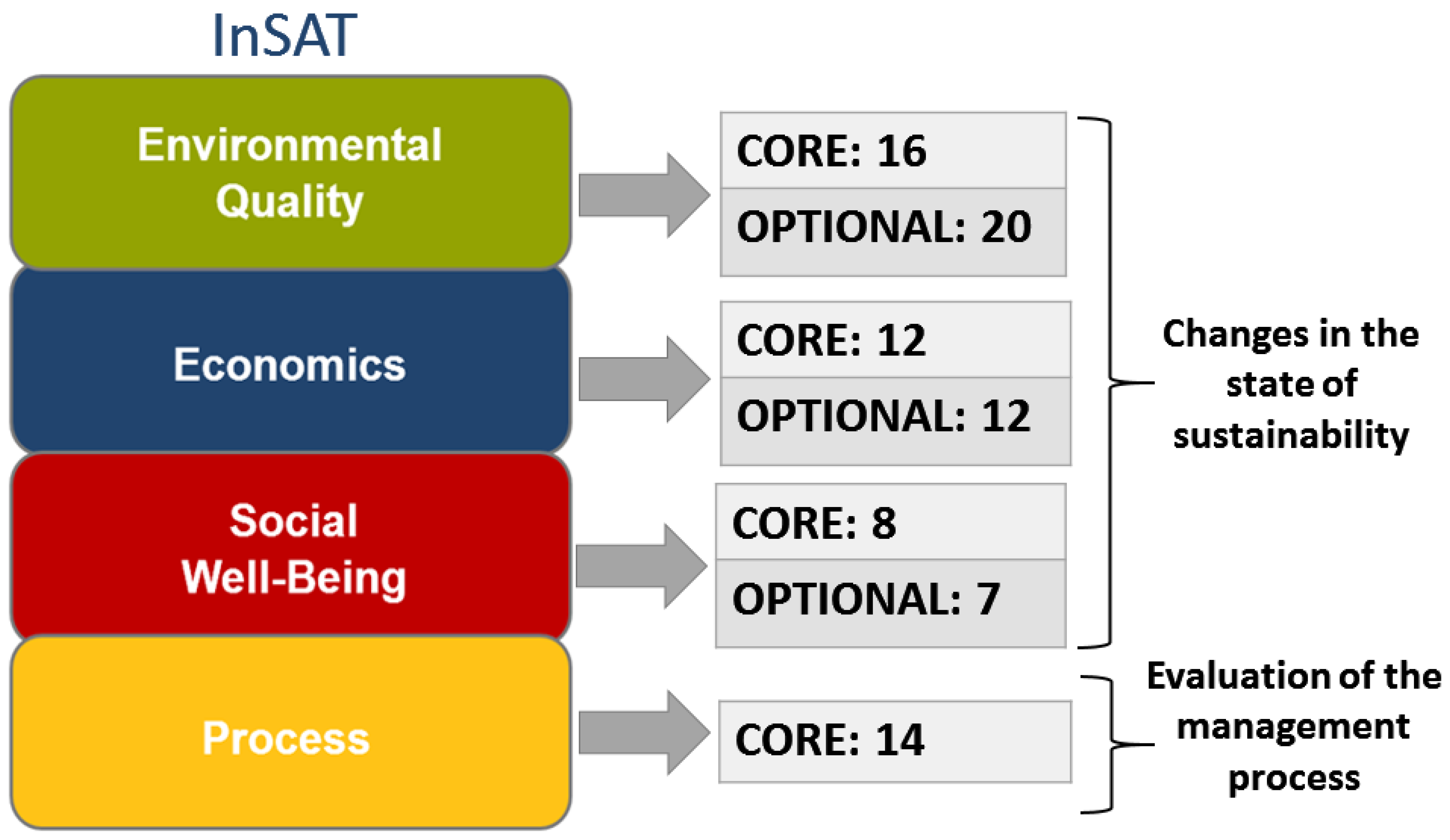
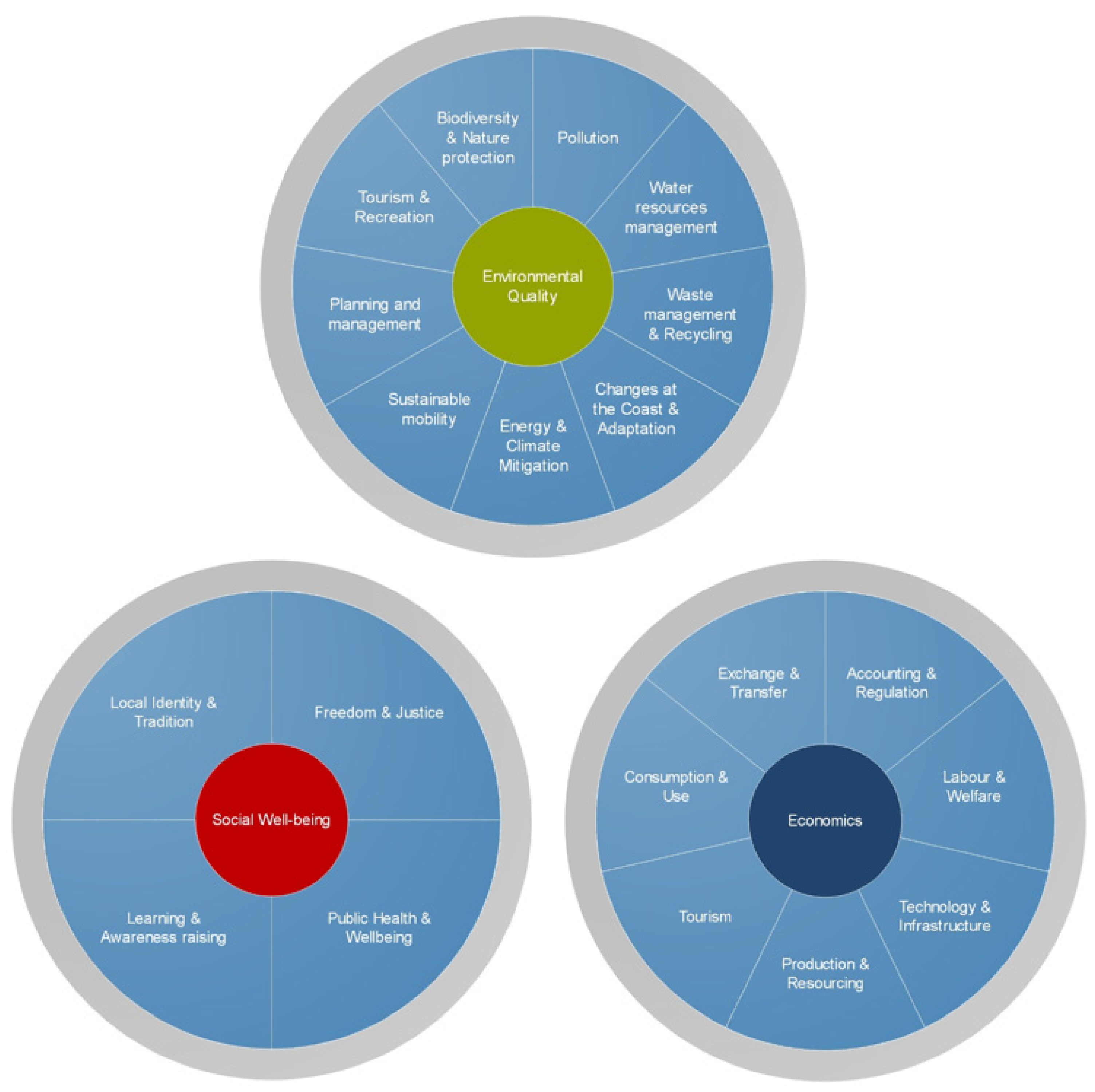
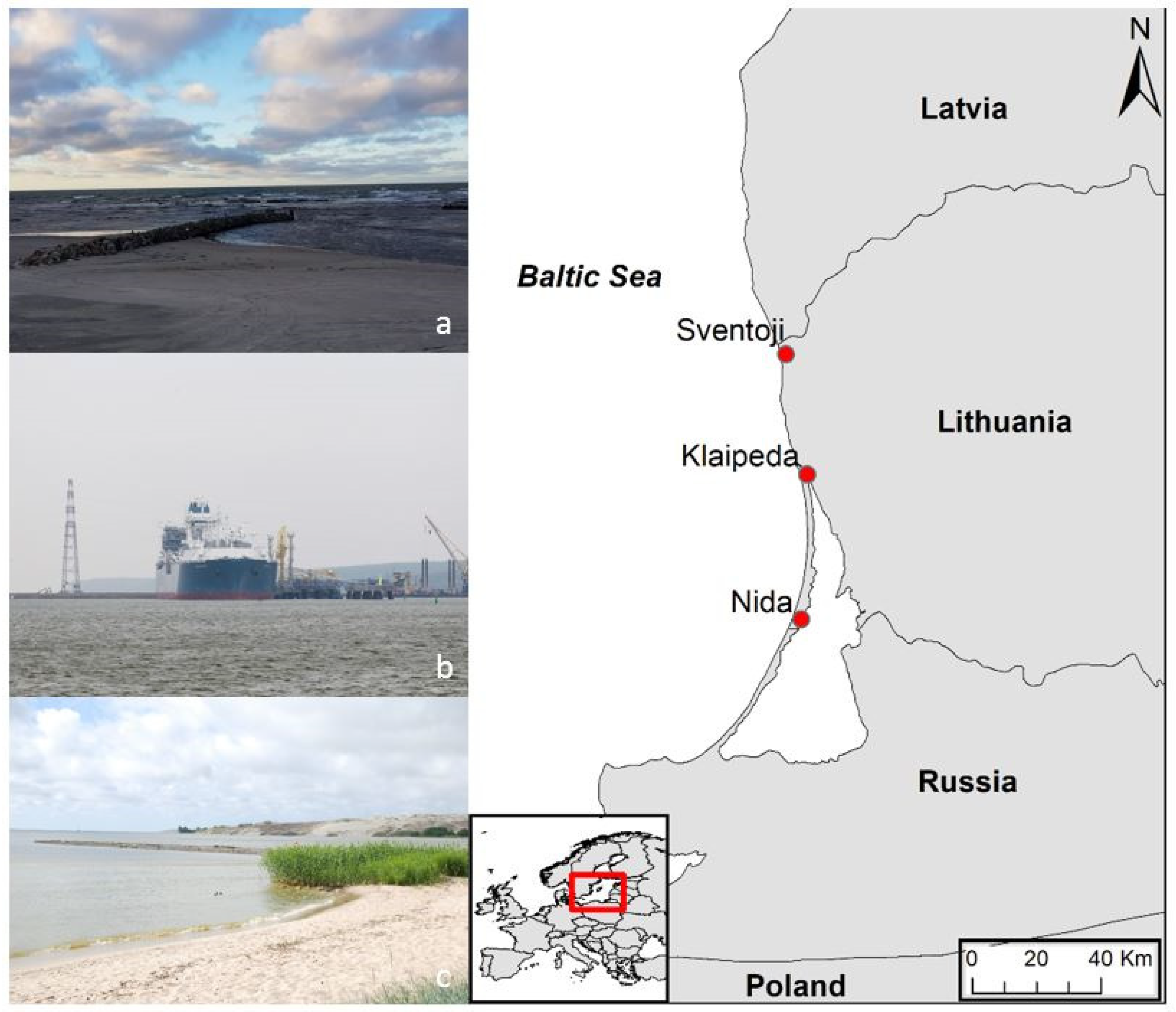
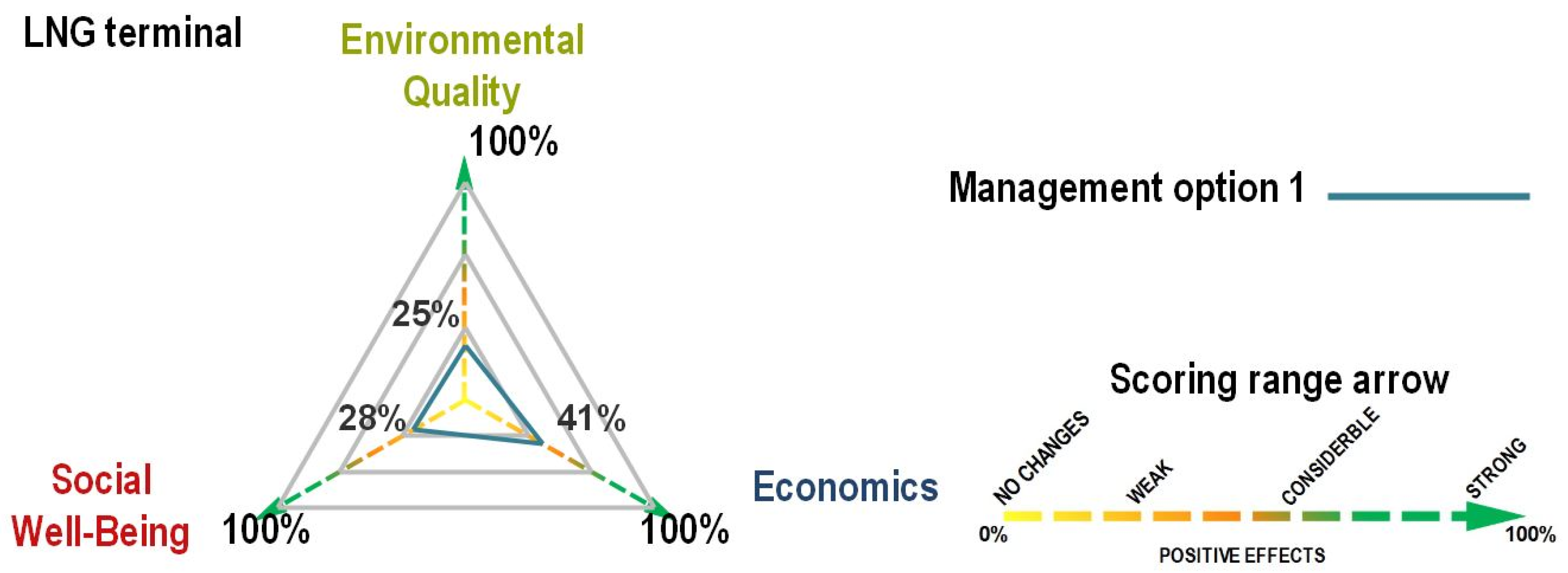
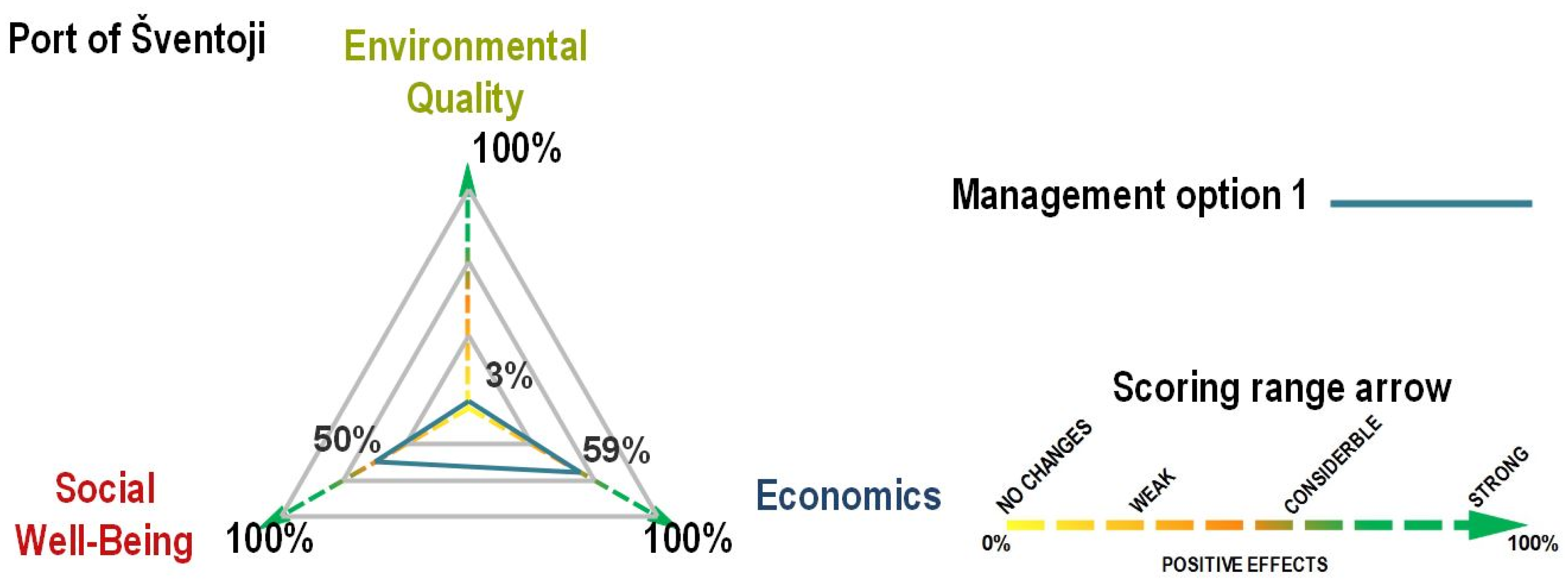
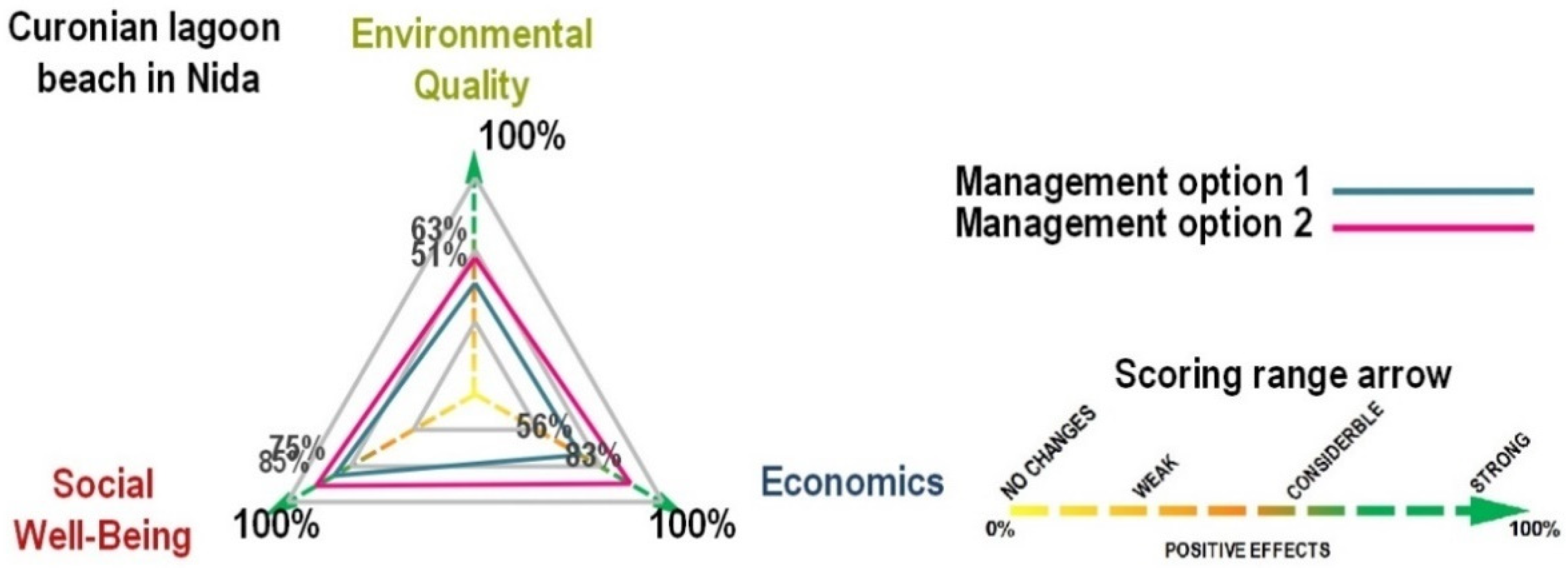
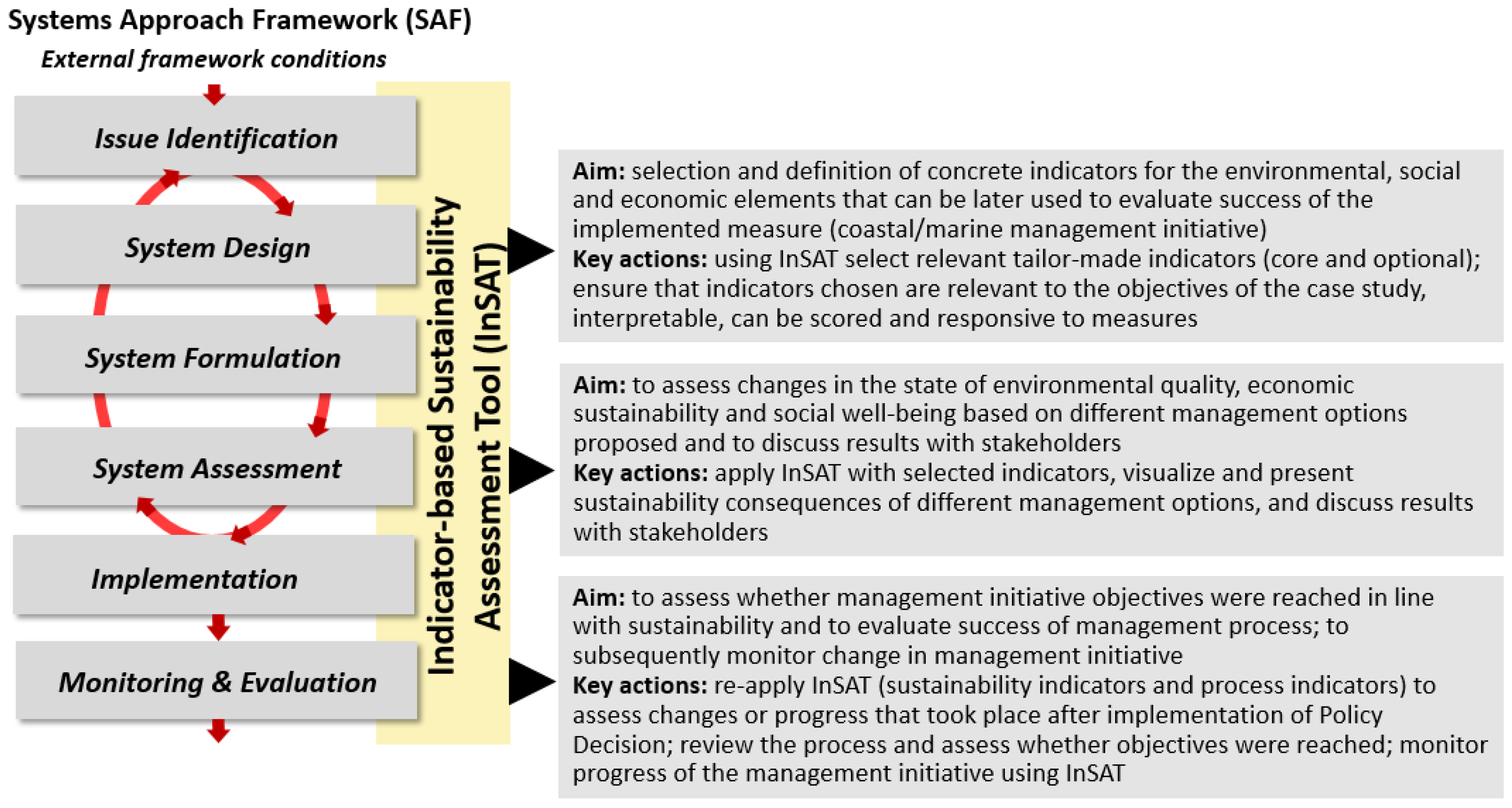
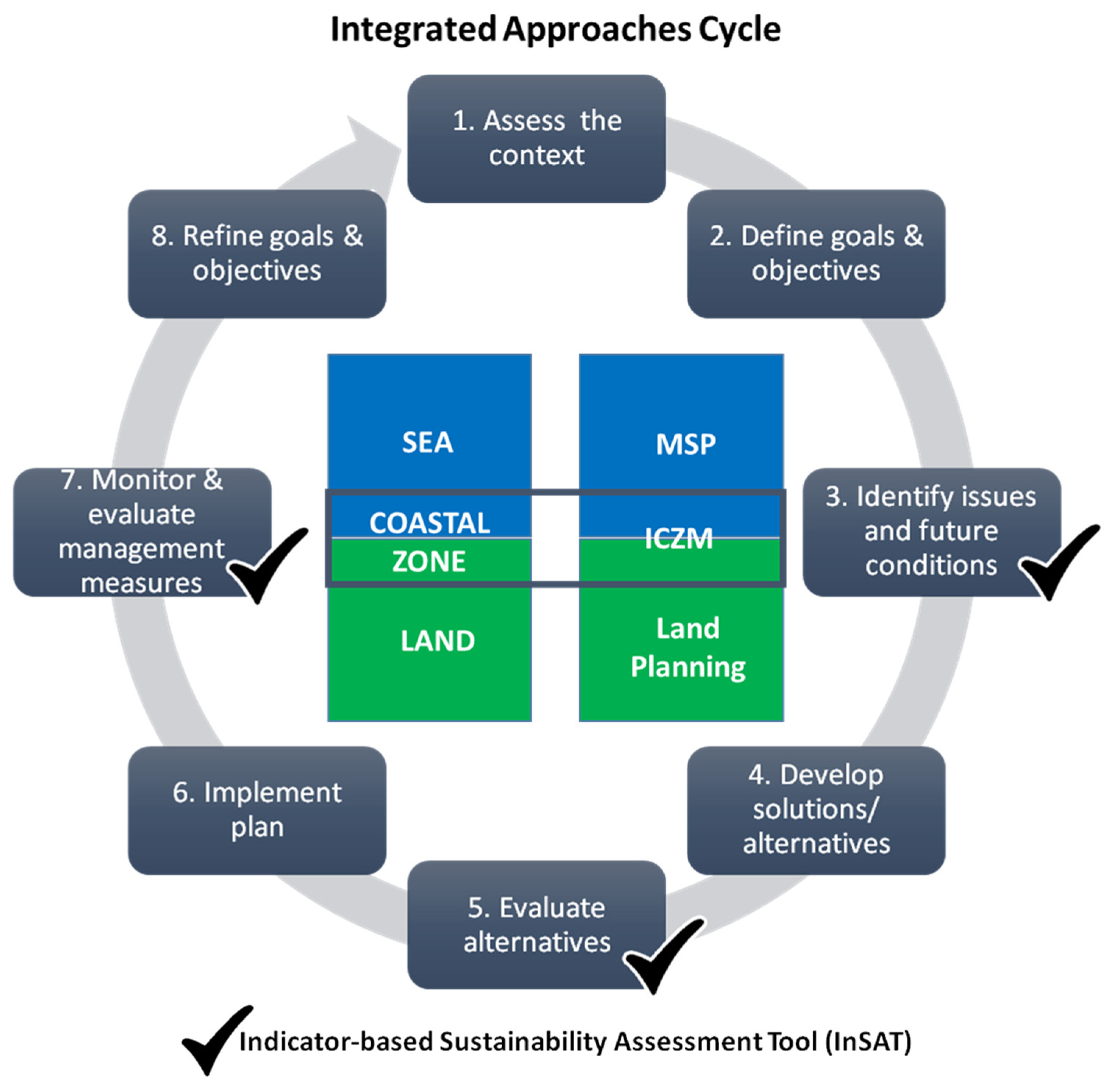
| Case Study (CS) | Objective of CS | Implementation Level: Application Objectives | Management Options (MO) |
|---|---|---|---|
| Klaipeda liquefied natural gas (LNG) floating storage and regasification unit terminal construction | To implement the LNG terminal which allows Lithuania to import natural gas from various countries around the world | Fully implemented: to assess the indicators’ suitability in identifying strengths and weaknesses of the implemented initiative and to measure the success of the implementation process; to assess the indicators’ suitability as a monitoring tool | LNG terminal is in place |
| Port of Sventoji renewal | To renew the port of Sventoji to develop and increase tourism | Implementation in progress: to demonstrate how indicators could be used in the planning process; to assess changes in sustainability comparing the situation now and after renewing port; to illustrate advantages and disadvantages of renewing a port; to identify the implementation shortcomings (the port renewing process was stopped) | Situation after renewing a port |
| Beach opening in Nida at Curonian Lagoon site | To establish the new beach for prolonging the bathing season | Hypothetical scenarios being proposed: to assess the indicators’ suitability in measuring sustainability of proposed hypothetical management options | Advertisement campaign: Advertisement campaign combined with change in infrastructure |
| Case Studies (CS) | Management Option (MO) | Indicators Used: Sustainability (S) or Process (P) | Optional Indicators Selected for the Assessment | Final Sustainability Score (%) | ||||||
|---|---|---|---|---|---|---|---|---|---|---|
| 1 | 2 | 3 | 4 | 5 | SG 1 | SG 2 | ||||
| CS 1 | MO 1 | S, P | Environmental Quality | |||||||
| 2, 3, 7, 13, 20 | 2, 3, 7, 13, 20 | 2, 3, 7, 18, 20 | 2, 3, 6, 13, 20 | − | 2, 3, 7, 14, 20 | − | 25.33 | |||
| Economic | ||||||||||
| 1, 4, 7, 8, 11 | 1, 4, 7, 8, 11 | 1, 2, 4, 8, 11 | 1, 4, 7, 8, 11 | − | 1, 2, 4, 8, 11 | − | 41 | |||
| Social Well-being | ||||||||||
| 1, 2, 4, 5, 6 | 1, 2, 4, 5, 6 | 1, 2, 4, 5, 6 | 2, 3, 4, 5, 6 | − | 2, 3, 4, 5, 6 | − | 27.67 | |||
| Process | ||||||||||
| not applicable | 70.25 | |||||||||
| CS 2 | MO 1 | S, P | Environmental Quality | |||||||
| 7, 11, 12, 14, 18 | 4, 7, 8, 11, 19 | 7, 11, 12, 14, 18 | 4, 7, 8, 11, 19 | − | 7, 11, 12, 15, 18 | − | 3.2 | |||
| Economic | ||||||||||
| 1, 4, 5, 8, 11 | 1, 4, 6, 10, 11 | 1, 4, 6, 8, 11 | 1, 5, 8, 10, 11 | − | 1, 5, 8, 10, 11 | − | 58.67 | |||
| Social Well-being | ||||||||||
| 1, 3, 4, 6, 7 | 1, 2, 3, 4, 5 | 1, 2, 4, 6, 7 | 1, 2, 4, 6, 7 | − | 1, 2, 4, 6, 7 | − | 50 | |||
| Process | ||||||||||
| not applicable | 50 | |||||||||
| CS 3 | MO 1 | S | Environmental Quality | |||||||
| 1, 4, 11, 12, 16 | 4, 6, 9, 16, 19 | 2, 4, 9, 13, 20 | 1, 11, 12, 16, 17 | 1, 4, 11, 12, 16 | 1, 4, 7, 11, 12 | 1, 4, 11, 12, 16 | 51 | |||
| Economic | ||||||||||
| 2, 3, 4, 10, 11 | 1, 4, 5, 10, 11 | 3, 4, 5, 10, 11 | 1, 5, 10, 11, 12 | 1, 4, 5, 10, 11 | 1, 4, 5, 10, 11 | 1, 4, 5, 10, 11 | 56 | |||
| Social Well-being | ||||||||||
| 1, 2, 3, 4, 6 | 1, 2, 3, 4, 6 | 1, 2, 3, 6, 7 | 1, 2, 3, 6, 7 | 1, 2, 3, 4, 6 | 1, 4, 5, 6, 7 | 1, 2, 4, 5, 6 | 75 | |||
| CS 3 | MO 2 | S | Environmental Quality | |||||||
| 1, 4, 11, 12, 16 | 4, 6, 11, 16, 17 | 2, 4, 9, 13, 20 | 1, 11, 12, 16, 17 | 4, 6, 11, 16, 17 | 1, 4, 7, 11, 12 | 1, 4, 7, 12, 16 | 63 | |||
| Economic | ||||||||||
| 2, 3, 4, 10, 11 | 1, 4, 5, 10, 11 | 3, 4, 5, 10, 11 | 1, 5, 10, 11, 12 | 1, 4, 5, 10, 11 | 1, 4, 5, 10, 11 | 2, 3, 4, 10, 11 | 83 | |||
| Social Well-being | ||||||||||
| 1, 2, 3, 4, 6 | 1, 2, 3, 4, 5 | 1, 2, 3, 6, 7 | 1, 2, 3, 6, 7 | 1, 2, 3, 6, 7 | 1, 4, 5, 6, 7 | 1, 2, 3, 4, 5 | 85 | |||
© 2019 by the authors. Licensee MDPI, Basel, Switzerland. This article is an open access article distributed under the terms and conditions of the Creative Commons Attribution (CC BY) license (http://creativecommons.org/licenses/by/4.0/).
Share and Cite
Karnauskaitė, D.; Schernewski, G.; Støttrup, J.G.; Kataržytė, M. Indicator-Based Sustainability Assessment Tool to Support Coastal and Marine Management. Sustainability 2019, 11, 3175. https://doi.org/10.3390/su11113175
Karnauskaitė D, Schernewski G, Støttrup JG, Kataržytė M. Indicator-Based Sustainability Assessment Tool to Support Coastal and Marine Management. Sustainability. 2019; 11(11):3175. https://doi.org/10.3390/su11113175
Chicago/Turabian StyleKarnauskaitė, Donalda, Gerald Schernewski, Josianne G. Støttrup, and Marija Kataržytė. 2019. "Indicator-Based Sustainability Assessment Tool to Support Coastal and Marine Management" Sustainability 11, no. 11: 3175. https://doi.org/10.3390/su11113175
APA StyleKarnauskaitė, D., Schernewski, G., Støttrup, J. G., & Kataržytė, M. (2019). Indicator-Based Sustainability Assessment Tool to Support Coastal and Marine Management. Sustainability, 11(11), 3175. https://doi.org/10.3390/su11113175






